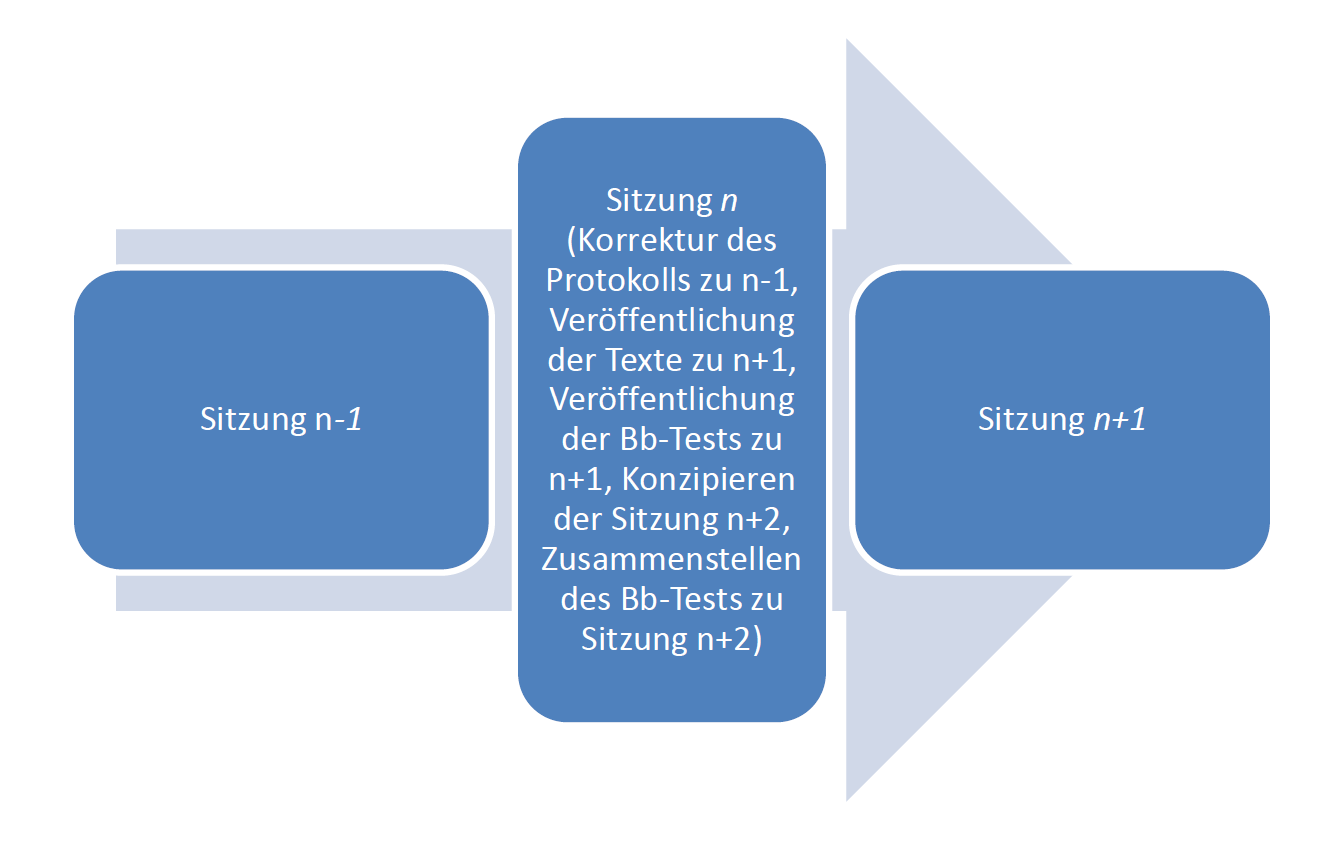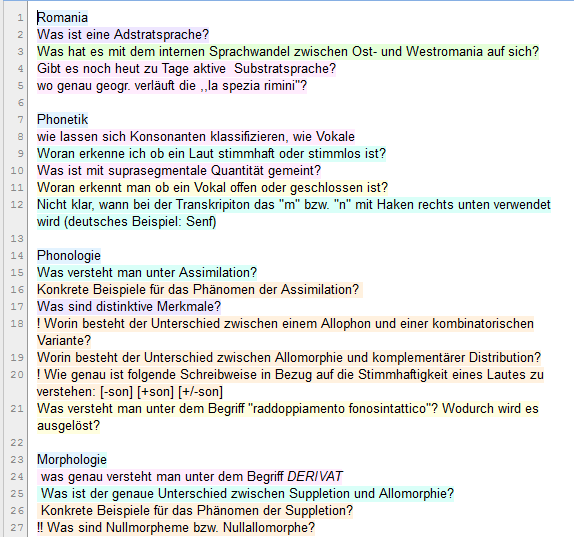...
| Tipp | ||
|---|---|---|
| ||
Summary The seminar for which this blended learning scenario was designed connects topic-wise to a preceding introductory lecture in which the theoretical basics of linguistics were introduced. On the one hand, it serves to deepen the students' knowledge of the content presented, and on the other hand the individual language application of both theory and methods. It combines a Seminar, für welches das vorliegende Blended-Learning-Szenario konzipiert ist, knüpft thematisch an eine vorausgehende Einführungsvorlesung an, in welcher theoretische Grundlagen der Linguistik übereinzelsprachlich eingeführt werden. Es dient einerseits der Vertiefung der dort präsentierten Inhalte, andererseits der einzelsprachlichen Anwendung von Theorien und Methoden. Es vereint eine mediengestützte Vorbereitung, welche aus der systematischen Wiederholung der Inhalte aus der Vorlesung besteht, und durch Blackboard-Tests sichergestellt wird, die Präsenzveranstaltungen, welche vollständig den Seminarzielen gewidmet werden können, und eine Nachbereitung, in der die Präsenzsitzungen in Gruppenarbeit protokolliert und im Blackboard-Wiki festgehalten werden. Gefördert wird das Heimstudium durch ein angekündigtes Einbinden der Fragen aus den Blackboard-Tests in die abschließende Klausurprüfung sowie durch eine anwendungszentrierte Gestaltung der Präsenzsitzungen, in welchen die entsprechende Vorarbeit vorausgesetzt wird.Didaktisch betrachtet ermöglicht dieses Blended-Learning-Konzept einen raschen Übergang von der Kompetenz des Kennens und Verstehens hin zu der des Anwendens und Evaluierens. Es bereitet systematisch auf die abschließende Lernkontrolle vor und hilft dabei, lernungünstige Frontalunterrichtsphasen in der Präsenz zu schmälern.a media-supported preparation which consists of the systematic repitition of the lecture contents and which is ensured through the Blackboard tests, the face-to-face seminars which completely focus on the seminar goals and a follow-up, in which the face-to-face meetings minutes are worked on in smaller groups and recorded in the Blackboard wiki. The studying at home is supported through the announced integration of the questions from the Blackboard tests in the final concluding exam as well as through an application-oriented design of the face-to-face sessions in which the corresponding preparatory work has to be done beforehand. Didactically seen, this blended learning concept allows for a quick progression from the competence of knowing and understanding to the application and evaluation of the knowledge learned. It prepares in a systematic manner for the final learning assessment and it helps to reduce the frontal teaching phases of the face-to-face sessions which are not favorable when it comes to the students' learning. |
| Panel | ||||
|---|---|---|---|---|
| ||||
|
Lehrveranstaltung
Course
| Course title | "Introduction to linguistics | Titel der Lehrveranstaltung | "Einführung in die Sprachwissenschaft" (GK B) |
| VeranstaltungstypCoure type | Grundlagenkurs | Basic course | |
LecturerLehrende/r | Valerie Hekkel | ||
TN-ZahlNo. of participants | Ca. 15 | ||
Phase | Parallel zu den Präsenzsitzungen, sitzungsvor- und -nachbereitend, verstärkt zur Prüfungsvorbereitung | ||
Dauer | Kursbegleitend, 1 Semester |
...
| to the face-to-face sessions, preparation and follow-up of the sessions, intensified usage for exam preparation | |
Duration | Course-accompanying, 1 semester |
Tools
- Blackboard
- Blackboard -Teststests
- Backboard -Wiki
wiki - Further web Weitere Web 2.0 -Werkzeugetools, ze. Bg.:
- Prezi
- Titanpad
- Pingo
| Info |
|---|
Externe Tools können ergänzend zu den zentralen Systemen der Freien Universität (Wiki, Blog, LMS usw.) eingesetzt werden. Die Beschreibung zu den externen Anwendungen (Informationen zu den Werkzeugen, Einsatzszenarien, Praxisbeispiele) finden Sie in der IdeenBar zu Lehre und Wissenschaft External tools can be implemented as a supplement to the central systems of the Freie Universität (wiki, blog, LMS etc.). The description of the external applications (information on tools, implementation scenarios, practical examples) can be found in the IdeasBar for teaching and science 2.0. |
Umsetzung
Die Blended-Learning-Veranstaltung besteht wöchentlich aus drei Phasen: der Vorbereitung, der Präsenzeinheit und der Nachbereitung. Sowohl die Phase der Vorbereitung als auch die der Nachbereitung werden in ein Blackboard-gestütztes Heimstudium verlagert. Die vorbereitende Arbeit besteht für die Studierenden aus dem Durcharbeiten sitzungsrelevanter und themenspezifischer Literatur sowie der anschließenden Bearbeitung entsprechender Tests in Blackboard. Diese Tests werden zwar als fakultativ ausgewiesen, allerdings setzt sich die Hälfte der abschließenden Klausur ausschließlich aus den Blackboard-Testfragen zusammen. Die Nachbearbeitung der Sitzung besteht aus einem Sitzungsprotokoll, das wöchentlich von je einer Kleinstgruppe im Blackboard-Wiki-System erstellt wird.
Da für ein erfolgreiches Umsetzen des Blended-Learning-Konzepts einerseits die Notwendigkeit besteht, dass die Bereitstellung der Inhalte einem konsequenten Timing folgt, andererseits diese auch von den Studierenden zeitnah bemerkt werden muss, sollte darauf geachtet werden, die Blackboard-Strukturen möglichst übersichtlich zu halten. Zu diesem Zweck wurden die Navigationselemente auf die Punkte Ankündigungen, Dozent/Dozentin (Block zu inhaltsunabhängigen Kursinformationen), Kursmaterial, Notizen-Wikis, Tests (Block zu Blended-Learning-Bestandteilen), Diskussionsforum und E-Mail-Verteiler (Block zur Kommunikation) reduziert.
Das Konzept erfordert folgendes Timing:
...
Was?
...
Durch wen?
...
Wann?
...
VORBEREITUNG
...
Veröffentlichung der sitzungsvorbereitenden Literatur
...
Lehrender
...
Eine Woche vor Sitzung
...
Erstellen und Freischalten des entsprechenden Blackboard-Tests
...
Lehrender
...
Freischaltung eine Woche vor der Sitzung, Zusammenstellen mit entsprechendem Vorlauf
...
Detaillierte Planung der Präsenzsitzung
...
Lehrender
...
Idealerweise 2 Wochen vor der Sitzung, sodass Blackboard-Test und Literatur entsprechend gewählt und angepasst werden können. Gestaltung der Folien kann auch in der Woche vor der Sitzung erfolgen.
...
Bearbeitung der Tests und Lesen der Literatur
...
Studierende
...
Ab einer Woche vor der Sitzung
...
NACHBEREITUNG
...
Erstellung des Sitzungsprotokolls
...
Wöchentlich wechselnde Kleinstgruppe (Studierende)
...
Bis 1 Woche nach der Sitzung
...
Korrektur des Sitzungsprotokolls
...
Lehrender
...
Am Tag der nachfolgenden Sitzung
Realization
The blended learning course consists of the following three phases on a weekly basis: the preparation, the face-to-face session and the follow-up. Both the phase of preparation as well as follow-up are transferred to Blackboard-supported home study sessions. The preparatory work for the students consists of working through the session-relevant and topic-related literature as well as the subsequent working on corresponding tests in Blackboard. These tests are voluntary; however, half of the final exam is made up of these Blackboard test questions. The follow-up of each session consits of writing up the meeting minutes which is undertaken by a small group and recorded in the Blackboard wiki system.
For a successful implementation of the blended learning concept it is on the one hand necessary that the provision of content is consequently planned and provided in a timely manner, and on the other hand it has to be ensured that the Blackboard coure structure is clear with a good overview so that the students can clearly see this and can find what they need when they need it. For this purpose the navigation buttons were reduced to News, Lecturer (a block that led to course information that was independent of the course contents), Course materials, Notes wiki, Tests (a block on the components of the blended learning design), Discussion forum and Mailing list (a block for communication).
The concept requires the following timing:
What? | By whom? | When? |
PREPARATION | ||
Posting the literature needed to prepare for the next session | Lecturer | One week before the session |
Creating and activating the corresponding Blackboard tests | Lecturer | Activation one week before the session, setting it up beforehand with the time needed for this |
Detailed planning of the face-to-face session | Lecturer | Ideally 2 weeks before the session, so that the Blackboard test and the literature required can be selected and if needs be adjusted. The design of the slides can also take place in the week before the session. |
Working on the tests and reading the literature | Students | As of one week before the session |
FOLLOW-UP | ||
Writing up the session's minutes | Weekly changing small groups (students) | Up to 1 week after the session |
Correcting the minutes | Lecturer | On the day of the subsequent session |
Presented differently, this means the following for the lecturer when it comes to the timing:
Illustration 1: Time planning
Apart from the weekly recurring work phases, digital media was also used intermittently. For example, for the preparation of the last session the students used a titanpad to create a cataloge of questions still open and unanswered (Illustration 2) which were answered and discussed with the help of the online tool pingo (Illustration 3).
Illustration 2: Question cataloge in the titanpad
Illustration 3: Questions per clicker (pingo)
Experiences made by the lecturer
All in all, the blended learning concept can be rated as a success. The literature was indeed read beforehand, the Blackboard tests were worked on by about 50% of the students on a weekly basis. Therefore the final exam grade was quite positive - as well as the feedback from the students. Especially the Blackboard tests were seen as being a sensible preparation for the final exam. However, designing a blended learning course is a lot more work (not least due to the strict timeplan) which turned into a manageable and quite doable routine after a while.
Anders dargestellt, bedeutet dies für den Lehrenden folgendes Timing:
Abbildung 1: Zeitplanung
Abgesehen von den wöchentlich rekurrierenden Arbeitsphasen wurden digitale Medien auch punktuell genutzt. So wurde zur Vorbereitung auf die letzte Sitzung seitens der Studierenden mittels Titanpad ein Katalog offengebliebener Fragen erstellt (Abbildung 2), die unter der Zuhilfenahme des Online-Tools Pingo (Abbildung 3) beantwortet und diskutiert wurde.
Abbildung 2: Fragenkatalog im Titanpad
Abbildung 2: Fragen per Clicker (Pingo)
Erfahrungen der Lehrenden
Insgesamt lässt sich das Blended-Learning-Konzept als Erfolg verbuchen. Die Literatur wurde tatsächlich im Voraus gelesen, die Blackboard-Tests immerhin von circa 50% der Studierenden wöchentlich bearbeitet. Dementsprechend positiv fielen auch die Klausur sowie das abschließende Feedback durch die Studierenden aus. Insbesondere die Blackboard-Tests wurden als sinnvolle Vorbereitung auf die Abschlussklausur gelobt. Allerdings bedeutete die Konzipierung dieser Blended-Learning-Veranstaltung auch einen (nicht zuletzt aufgrund der strengen Taktung) enormen Mehraufwand, der sich jedoch bald routinisieren ließ.
Further information
Link in New Window linkText Prezi zu der ersten Sitzung der Veranstaltung href https://prezi.com/s1tvmhcveypm/einfuhrung-in-die-sprachwissenschaft-gk/?utm_campaign=share&utm_medium=copy Link in New Window linkText Prezi zu Fazit und Evaluationsergebnissen href https://prezi.com/-kl_nf0-e282/e-teaching/?utm_campaign=share&utm_medium=copy
...


